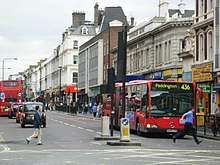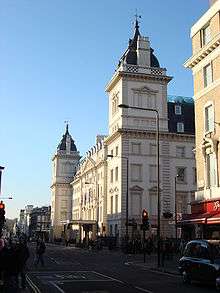Praed Street
Praed Street (/preɪd/) is a street in Paddington, west London, in the City of Westminster, most notable for being the location of London Paddington station.[1] It runs south-westerly, straight from Edgware Road to Craven Road, Spring Street and Eastbourne Terrace.
 Praed Street in 2007 | |
| Length | 0.4 mi (0.6 km) |
|---|---|
| Location | Paddington, London, United Kingdom |
| Postal code | W2 |
| Nearest train station | |
| South end | Edgware Road |
| West end | Eastbourne Terrace |
| Other | |
| Known for | London Paddington station; the Great Western Hotel; St Mary's Hospital |


History
Praed Street was originally laid out in the early 19th century, being built up in 1828. It was named after William Praed, chairman of the company which built the canal basin which lies just to the north.[2]
In 1893 plans were put forward by the Edgware Road and Victoria Railway company to build an underground railway along the Edgware Road which included the construction of a Tube station at Praed Street. The scheme was rejected by Parliament and the line was never built.[3]
Overview
On the north west side of the street are Paddington Station and the Great Western Hotel, the Royal Mail Western depot, and St Mary's Hospital. The south east side is predominantly retail but includes the frontage for Paddington Underground (Bakerloo, Circle and District lines) station. At the far north east end, on the north west side, is a prominent 1980s extension to the Hilton London Metropole Hotel.
Affecting Underground railway staff and travellers, Praed Street is the site of a crucial junction of the Hammersmith & City and Circle lines. Problems at this junction cause many delays on the Circle, District and Hammersmith & City lines. Westbound Hammersmith & City trains need to turn in front of eastbound Circle or District trains bound for Edgware Road. During normal operation, trains are signalled across the junction in the order they appear in the timetable. So, if an eastbound Circle or District train is scheduled into Edgware road station first, then a westbound train would have to wait. Similarly if a Hammersmith & City line train is coming off the branch, then any eastbound train from Paddington will have to wait. Typically, trains queue up to get into Edgware Road from Paddington (Circle line) and Baker Street. A further complication is that all trains are held to time by the Edgware Road signal box.
In literature and film
Solar Pons, a pastiche of Sherlock Holmes created by August Derleth, had his offices based at 7B Praed Street.[5]
American poet Richard Hugo wrote the poem "Walking Praed Street", which first appeared in his book of poems, The Lady in Kicking Horse Reservoir. The poem's first two lines are said to be two of the greatest American lines ever written: "I've walked this street in far too many towns./ The weather, briefly: in Salerno, rain."
Praed Street appeared in the political thriller novel House of Cards, and subsequently in its television adaptation, as an accommodation address set up by main protagonist Francis Urquhart as part of a plot to force the resignation of the sitting Prime Minister.[6]
Praed Street is the setting for the novel The Murders in Praed Street by John Rhode.
Praed Street is mentioned in Ira Levin's Rosemary's Baby. Somebody compares a house there with the house (Bramford in New York) where the protagonists live: "There was a house in London, on Praed Street, in which five separate brutal murders took place within sixty years."
In The Dark Labyrinth by Lawrence Durrell, a character complains he 'could not be carried away by fairy tales of the Second Coming written in this Praed Street vein' (chapter three).
See also
References
- Humphreys, Rob; Judith Bamber (2003). London. Rough Guides. pp. 330–331. ISBN 1-84353-093-7.
Praed Street Paddington station.
- Thorne, R. G. (1986). R. Thorne (ed.). PRAED, William (1747–1833), of Tyringham, Bucks. and Trevethoe, nr. St. Ives, Cornw. The History of Parliament: the House of Commons 1790–1820. Retrieved 16 September 2015.
- Badsey-Ellis, Antony (2005). London's Lost Tube Schemes. Capital Transport. ISBN 1-85414-293-3.
- "The London Diplomatic List" (PDF). 14 December 2013.
- Derleth, A. (1928) The Adventure of the Norcross Riddle, reprinted in In Re: Sherlock Holmes (Mycroft & Moran, 1945)
- Dobbs, Michael (2013). House of Cards. Simon and Schuster. ISBN 978-1-4711-2852-3.